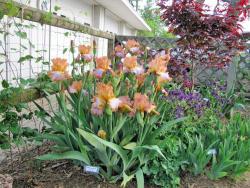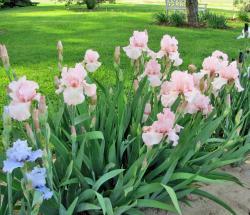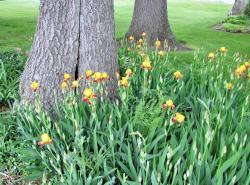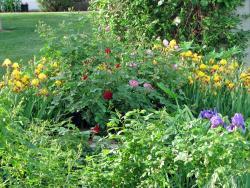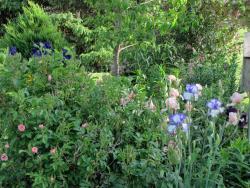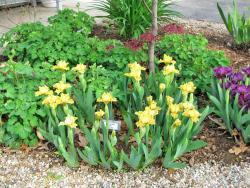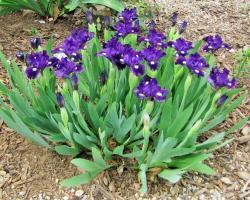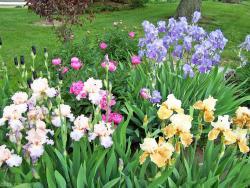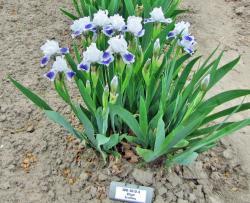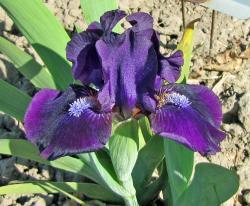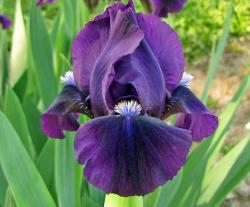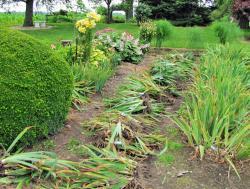
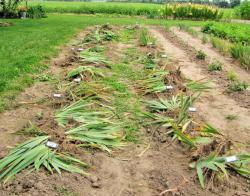 A vital part of a landscape that should (must) change over time is in the iris gardens. I use irises in almost every garden setting, and plant as many different ones as possible. But, irises have special needs: They are not carefree! Some folks will plant an iris rhizome and expect it to remain in place for millennia. Wrong! Depending on the class and variety of iris plants, growth and increase in size and volume can be overwhelming. For the sake of this discussion I will limit the classification to bearded irises, MDB, SDB, BB and TB primarily. Once the plants grow and expand into neighboring clumps there is little room for air circulation and lack of sunlight reaching the rhizomes. These two factors cause disease risks to be elevated. These conditions also contribute to diminished bloom, dry rot, bacterial soft rot, and mustard seed fungus. There is another pathogen called Erwinia carotovora which is a plant bacteria capable of causing rot problems, especially in hot, humid weather. (This pathogen can cause heavy losses in vegetable crops too. Some that can be affected include cotton, onions, carrots, corn, potatoes and others.) In the two pictures at right I've dug and separated two major iris beds in preparation for division, cleaning, disinfecting and replanting. When this process is complete I will keep back only two or three rhizomes for replant; the rest are given away to neighboring gardeners and to irisarians at the ATP (NGA) Iris Forum. Many of these pictured here have gone to several states in the eastern U. S. the summer of 2015. At least 100 different rhizomes went to Arkansas and Pennsylvania alone. Others went to Iowa, Massachusetts, Oklahoma and Illinois.
A vital part of a landscape that should (must) change over time is in the iris gardens. I use irises in almost every garden setting, and plant as many different ones as possible. But, irises have special needs: They are not carefree! Some folks will plant an iris rhizome and expect it to remain in place for millennia. Wrong! Depending on the class and variety of iris plants, growth and increase in size and volume can be overwhelming. For the sake of this discussion I will limit the classification to bearded irises, MDB, SDB, BB and TB primarily. Once the plants grow and expand into neighboring clumps there is little room for air circulation and lack of sunlight reaching the rhizomes. These two factors cause disease risks to be elevated. These conditions also contribute to diminished bloom, dry rot, bacterial soft rot, and mustard seed fungus. There is another pathogen called Erwinia carotovora which is a plant bacteria capable of causing rot problems, especially in hot, humid weather. (This pathogen can cause heavy losses in vegetable crops too. Some that can be affected include cotton, onions, carrots, corn, potatoes and others.) In the two pictures at right I've dug and separated two major iris beds in preparation for division, cleaning, disinfecting and replanting. When this process is complete I will keep back only two or three rhizomes for replant; the rest are given away to neighboring gardeners and to irisarians at the ATP (NGA) Iris Forum. Many of these pictured here have gone to several states in the eastern U. S. the summer of 2015. At least 100 different rhizomes went to Arkansas and Pennsylvania alone. Others went to Iowa, Massachusetts, Oklahoma and Illinois.
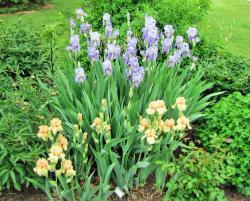
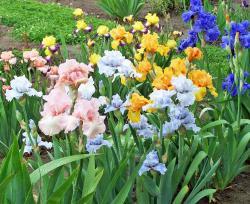 In the pictures below the one at left shows the proper replant of the rhizome from Holy Night a TB iris. The second picture below shows an over-crowded clump of Holy Night which actually resulted in the replants of the first picture. The last two pictures show clumps (at left & right in this paragraph) which are nearing the 'dig & divide' category. They will be scheduled for 'dig and replant' in 2016 or possibly 2017. The picture at right from my own gardens shows a tranquil scene which upon closer inspection hides an invitation for trouble! Plants have clearly grown together at their bases with rhizomes and foliage 'smothering' each other. Conditions like this invite disease and insect problems mentioned above.
In the pictures below the one at left shows the proper replant of the rhizome from Holy Night a TB iris. The second picture below shows an over-crowded clump of Holy Night which actually resulted in the replants of the first picture. The last two pictures show clumps (at left & right in this paragraph) which are nearing the 'dig & divide' category. They will be scheduled for 'dig and replant' in 2016 or possibly 2017. The picture at right from my own gardens shows a tranquil scene which upon closer inspection hides an invitation for trouble! Plants have clearly grown together at their bases with rhizomes and foliage 'smothering' each other. Conditions like this invite disease and insect problems mentioned above.
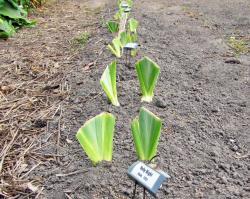



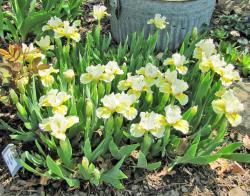
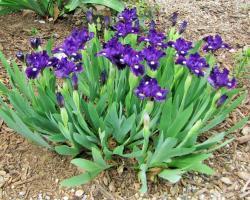 ]
]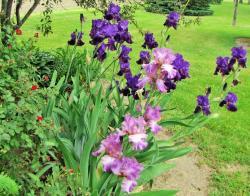
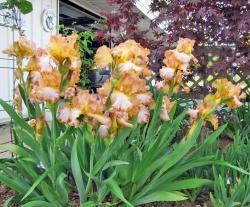


 Hello and welcome to my blog. I am known as TBGDN (Tall Bearded Iris Garden). A lot of metaphoric water has flowed under my proverbial bridge since the picture was taken at left and the one at right. I seem to be a "Jack of all trades", but master of none. My interests are varied and many. They range from aircraft design to wildlife, photography, gardening of all kinds, and reading. I enjoy in-depth Bible study. Hebrew and Greek manuscripts are particularly interesting. Pets are among my every day care and concerns. I am currently assigned to two firmly attached cats and assorted mix of chickens. I appreciate your visit, and I hope you'll stop by again! Everyone is most welcome!
Hello and welcome to my blog. I am known as TBGDN (Tall Bearded Iris Garden). A lot of metaphoric water has flowed under my proverbial bridge since the picture was taken at left and the one at right. I seem to be a "Jack of all trades", but master of none. My interests are varied and many. They range from aircraft design to wildlife, photography, gardening of all kinds, and reading. I enjoy in-depth Bible study. Hebrew and Greek manuscripts are particularly interesting. Pets are among my every day care and concerns. I am currently assigned to two firmly attached cats and assorted mix of chickens. I appreciate your visit, and I hope you'll stop by again! Everyone is most welcome!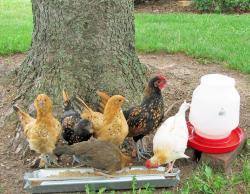



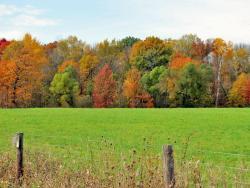
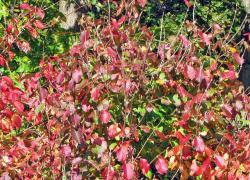 There is nothing more spectacular in the fall than the change of leaf colors throughout the woodlands of North America. The photos shown here are all taken from rural roads nearby my home. I try to set aside some extra time when I can make a deliberate effort to get some pictures. It is difficult when the weather is all cloudy and windy with little sunlight. The sun is so important in bringing out the best natural colors. I like to take photos with the sun off to the south from the subject landscape as much as possible. It does not have to be a blinding, bright sun, but at least enough to bring out the best colors. I also like as much blue sky as possible in the background. In the picture at left more sunlight would have improved the overall quality of colors while the one at right has enough sun on the leaves to give them a 'shiny' effect. The one at left contains, oaks, maples, willows, sassafras and a couple of sycamores. The one at right is unidentified.
There is nothing more spectacular in the fall than the change of leaf colors throughout the woodlands of North America. The photos shown here are all taken from rural roads nearby my home. I try to set aside some extra time when I can make a deliberate effort to get some pictures. It is difficult when the weather is all cloudy and windy with little sunlight. The sun is so important in bringing out the best natural colors. I like to take photos with the sun off to the south from the subject landscape as much as possible. It does not have to be a blinding, bright sun, but at least enough to bring out the best colors. I also like as much blue sky as possible in the background. In the picture at left more sunlight would have improved the overall quality of colors while the one at right has enough sun on the leaves to give them a 'shiny' effect. The one at left contains, oaks, maples, willows, sassafras and a couple of sycamores. The one at right is unidentified.
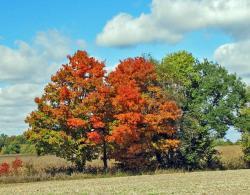
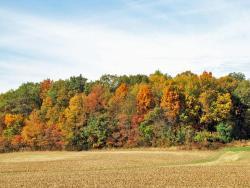



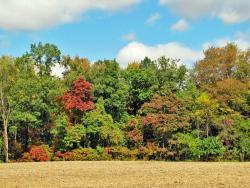
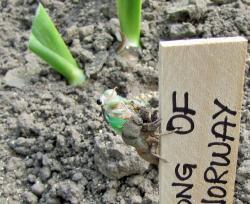 Since childhood I've been curious about these 'wierdos of nature'. I can recall hot summer afternoons when the incessant buzzing could be heard from almost every tree top. It seems one would wind down its 'Zzzzzzzzz' symphony of noisy irritation, and then another one would begin its refrain from a different tree. The pitch and volume of sound would begin as a low 'rattling buzz', then gradually accelerate to very high volume, and finally a descending tone down to zero. These sounds of mid and late summer were likely ignored by most, but not me. It seems even now, as well as then, they kept making this monotonous racket from morning sunlight until evening sunset! I remember asking in childhood innocence about them only to get a half-dozen different answers from as many adults! Some referred to them as 'locusts' or 'jar flies' while others said they were 'katydids' or some other insect. For unknown reasons I failed to explore and research more this mystery insect until later years. And just recently while re-planting irises my plant label served as a transformation rest stop for one of these little noise makers! It was then I remembered a few years back having taken some pictures of them in various stages of emergence from their larval shell. While the subject of cicadas might not appeal to most gardeners, I find it interesting the way it fits into the scheme of nature.
Since childhood I've been curious about these 'wierdos of nature'. I can recall hot summer afternoons when the incessant buzzing could be heard from almost every tree top. It seems one would wind down its 'Zzzzzzzzz' symphony of noisy irritation, and then another one would begin its refrain from a different tree. The pitch and volume of sound would begin as a low 'rattling buzz', then gradually accelerate to very high volume, and finally a descending tone down to zero. These sounds of mid and late summer were likely ignored by most, but not me. It seems even now, as well as then, they kept making this monotonous racket from morning sunlight until evening sunset! I remember asking in childhood innocence about them only to get a half-dozen different answers from as many adults! Some referred to them as 'locusts' or 'jar flies' while others said they were 'katydids' or some other insect. For unknown reasons I failed to explore and research more this mystery insect until later years. And just recently while re-planting irises my plant label served as a transformation rest stop for one of these little noise makers! It was then I remembered a few years back having taken some pictures of them in various stages of emergence from their larval shell. While the subject of cicadas might not appeal to most gardeners, I find it interesting the way it fits into the scheme of nature.

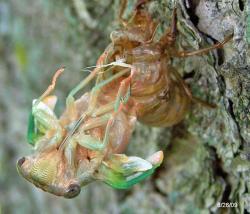 I remember once in the 1990's watching an outdoor live press briefing at the White House where reporters scrambled to ask questions about some scandal that was then 'allegedly' breaking. Answers were as usual vague, and almost inaudible because of the sounds of numerous cicadas coming from the surrounding trees. This appeared to me quite humorous since the cicadas seemed to be aiding the futile efforts of the white house staffer to minimize any appearance of 'alleged scandal'! Most would think this 'cover-up' of hundreds of insects was pre-planned or pre-meditated. But, just how preposterous would that be: An act of nature conspiring with politicians? I don't think so. The pictures accompanying this paragraph were ones I had archived from 2009. They clearly show the cicadas morphing from the shell casings of their larval stage into their more adult recognizable forms. While this process might seem grotesque to some I find it very educational and enlightening.
I remember once in the 1990's watching an outdoor live press briefing at the White House where reporters scrambled to ask questions about some scandal that was then 'allegedly' breaking. Answers were as usual vague, and almost inaudible because of the sounds of numerous cicadas coming from the surrounding trees. This appeared to me quite humorous since the cicadas seemed to be aiding the futile efforts of the white house staffer to minimize any appearance of 'alleged scandal'! Most would think this 'cover-up' of hundreds of insects was pre-planned or pre-meditated. But, just how preposterous would that be: An act of nature conspiring with politicians? I don't think so. The pictures accompanying this paragraph were ones I had archived from 2009. They clearly show the cicadas morphing from the shell casings of their larval stage into their more adult recognizable forms. While this process might seem grotesque to some I find it very educational and enlightening.

 Once again summer has prompted me to think about planning for its end! I am reminded of this when I begin to hear the cicadas performing their annual songs of 'doom'. I understand they emerge from their larval stage of metamorphosis; and then complete their life cycles in treetops where the males make their loud noises to attract females. Now, I do not claim to be a rocket scientist, biology professor or entomologist! My thoughts here are based solely on what I have seen, heard & briefly researched; and the related facts are available to everyone by means of internet and endless on-line resources. Simply put, I only want to share a few parting thoughts on this subject. The main idea for me is that summer has begun to grow 'old' when these sounds begin to be heard. It is always with a little sadness that my calendar says 'August': I dread the coming winter, but want to enjoy an autumn of outdoors, trees and Indian summer. (I am editing this post on September 25, 2017 to add a link which illustrates the incessant buzzing of these insects.) Click here for a listen: https://www.youtube.com/watch?...
Once again summer has prompted me to think about planning for its end! I am reminded of this when I begin to hear the cicadas performing their annual songs of 'doom'. I understand they emerge from their larval stage of metamorphosis; and then complete their life cycles in treetops where the males make their loud noises to attract females. Now, I do not claim to be a rocket scientist, biology professor or entomologist! My thoughts here are based solely on what I have seen, heard & briefly researched; and the related facts are available to everyone by means of internet and endless on-line resources. Simply put, I only want to share a few parting thoughts on this subject. The main idea for me is that summer has begun to grow 'old' when these sounds begin to be heard. It is always with a little sadness that my calendar says 'August': I dread the coming winter, but want to enjoy an autumn of outdoors, trees and Indian summer. (I am editing this post on September 25, 2017 to add a link which illustrates the incessant buzzing of these insects.) Click here for a listen: https://www.youtube.com/watch?...

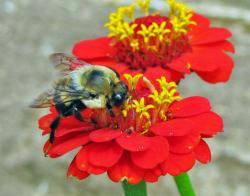
 Hello, and welcome to my blog. I am known as "TBGDN" an acronym meaning "Tall Bearded Iris Gardener". I tend to be a "Jack of all trades", but master of none. My first love is to be outdoors at every possible moment. I belong in my spirit and soul to the woodlands, fields, lakes and streams which are abundant here, or at least adequate. I especially enjoy animals, birds and plant life which abound in these places. I realize we are all put together somewhat differently in body, mind and spirit; yet we share so many common interests. Thanks for stopping by & I hope you'll visit again.
Hello, and welcome to my blog. I am known as "TBGDN" an acronym meaning "Tall Bearded Iris Gardener". I tend to be a "Jack of all trades", but master of none. My first love is to be outdoors at every possible moment. I belong in my spirit and soul to the woodlands, fields, lakes and streams which are abundant here, or at least adequate. I especially enjoy animals, birds and plant life which abound in these places. I realize we are all put together somewhat differently in body, mind and spirit; yet we share so many common interests. Thanks for stopping by & I hope you'll visit again.
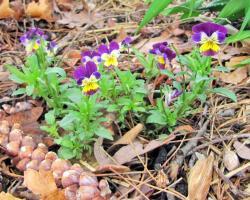
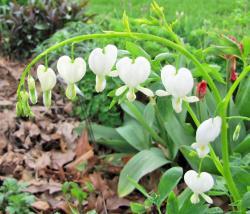 Meteorological summer begins here in the heartland on June 1st, and continues through August. It is a transition time from spring bulbs, dandelions, and lilacs to sounds of lawn mowers, peonies in flower and the last blooms of the irises. Then suddenly, regardless of what adjective we put in front of the word, “summer” is here! School is out; heat and humidity increase and the garden activities are in full swing! For us country bumpkins it’s a never ending season of labors of love. I could go on and on about planning and looking forward, but that has been addressed in another article. For this article it is simply about enjoying the three-month period on the calendar known as summer. When we were younger (speaking personally) it was about the carefree days of no school, girls and hot cars. And of course there was the real music of the teen-age 60’s; notably HERE COMES SUMMER. Those were the days of pure innocence, but yet they were even more enjoyable because of that innocence and all the other things that made the summers back then so memorable. I sometimes think that I must have been the black sheep in the family because my father placed me in an iris field with a hoe in my hand as a freshman in high school. "You've got to earn some money for school", he demanded. God love him; little did he know I had my heart set on a hot '57 Chevy Bel Air! Those were very ‘hot’ back then, (especially the baby blue & white) but now a ‘classic’! (I never got the '57, but eventually saved enough money for a '59.)
Meteorological summer begins here in the heartland on June 1st, and continues through August. It is a transition time from spring bulbs, dandelions, and lilacs to sounds of lawn mowers, peonies in flower and the last blooms of the irises. Then suddenly, regardless of what adjective we put in front of the word, “summer” is here! School is out; heat and humidity increase and the garden activities are in full swing! For us country bumpkins it’s a never ending season of labors of love. I could go on and on about planning and looking forward, but that has been addressed in another article. For this article it is simply about enjoying the three-month period on the calendar known as summer. When we were younger (speaking personally) it was about the carefree days of no school, girls and hot cars. And of course there was the real music of the teen-age 60’s; notably HERE COMES SUMMER. Those were the days of pure innocence, but yet they were even more enjoyable because of that innocence and all the other things that made the summers back then so memorable. I sometimes think that I must have been the black sheep in the family because my father placed me in an iris field with a hoe in my hand as a freshman in high school. "You've got to earn some money for school", he demanded. God love him; little did he know I had my heart set on a hot '57 Chevy Bel Air! Those were very ‘hot’ back then, (especially the baby blue & white) but now a ‘classic’! (I never got the '57, but eventually saved enough money for a '59.)
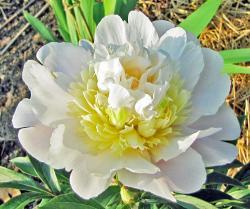
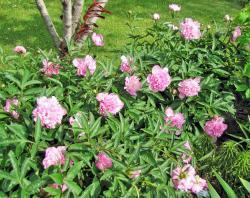 Fast forward quickly to 2015. The times have changed- immensely! Gone now are those days of innocence when summers were relatively carefree. Or, am I seeing things in a different light since maturing into a retired ‘senior citizen’? Am I now looking at the world differently, and fairly? Or, did I just ignore all the major problems back then with a child-like attitude? I cannot honestly answer my own question: Summers come, and they go. But I guess the question that needs to be answered is do we really take the time to enjoy them? Or, do we just rush through them and let them slip away? Do we really take time to ‘stop and smell the roses’? What about all the other things of summer? I suppose the answer lies with each of us individually.. My biggest fear is that I won’t be able to enjoy every part of the summer season. That includes cook outs, drinking ice tea on a shady deck and working in the gardens on hot summer days! It also means sharing summer experiences with family and friends as well as ATP members in forums, blogs and data base posts!
Fast forward quickly to 2015. The times have changed- immensely! Gone now are those days of innocence when summers were relatively carefree. Or, am I seeing things in a different light since maturing into a retired ‘senior citizen’? Am I now looking at the world differently, and fairly? Or, did I just ignore all the major problems back then with a child-like attitude? I cannot honestly answer my own question: Summers come, and they go. But I guess the question that needs to be answered is do we really take the time to enjoy them? Or, do we just rush through them and let them slip away? Do we really take time to ‘stop and smell the roses’? What about all the other things of summer? I suppose the answer lies with each of us individually.. My biggest fear is that I won’t be able to enjoy every part of the summer season. That includes cook outs, drinking ice tea on a shady deck and working in the gardens on hot summer days! It also means sharing summer experiences with family and friends as well as ATP members in forums, blogs and data base posts!
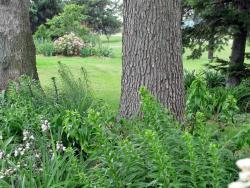
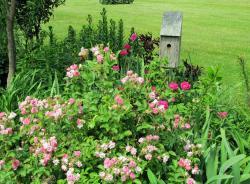 Roses follow closely behind the irises and peonies. They are especially nice in the summer landscape when they re-bloom. The early ones are susceptible to the brown rose chafers and Japanese Beetles here in my central part of the state. The chafers arrive about the first week of June and the Japanese Beetles are always on time at the end of the month. Both can cause damage to all blooming plants; not just roses alone. I’ve seen them devouring flowering annuals and perennials as well as soy beans and field corn silks. Even with these pests I feel the inclusion of roses is well worth the time and effort involved with caring for them. Among the most fragrant are the shrub rose 'White Rose of York' and another white shrub/climber 'Iceberg'. Both can perfume an entire the yard on warm summer days and evenings. And both are equally attractive in the landscape. Bear in mind this is the mid-section of the U. S.- NOT California! Our winters are brutal here; often matching Minnesota and the upper Midwest.
Roses follow closely behind the irises and peonies. They are especially nice in the summer landscape when they re-bloom. The early ones are susceptible to the brown rose chafers and Japanese Beetles here in my central part of the state. The chafers arrive about the first week of June and the Japanese Beetles are always on time at the end of the month. Both can cause damage to all blooming plants; not just roses alone. I’ve seen them devouring flowering annuals and perennials as well as soy beans and field corn silks. Even with these pests I feel the inclusion of roses is well worth the time and effort involved with caring for them. Among the most fragrant are the shrub rose 'White Rose of York' and another white shrub/climber 'Iceberg'. Both can perfume an entire the yard on warm summer days and evenings. And both are equally attractive in the landscape. Bear in mind this is the mid-section of the U. S.- NOT California! Our winters are brutal here; often matching Minnesota and the upper Midwest.
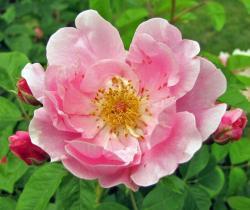
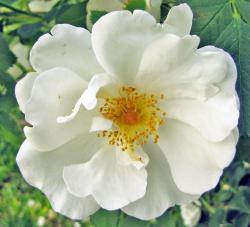
 Hello, I am known as TBGDN (Tall Bearded Iris Garden). I am the author of this blog, and I appreciate you stopping by. My ideas and opinions are based on and influenced by a lifetime of rural, agricultural lifestyle. We all see the world from differing viewpoints; yet we seem to hold a common bond when it comes to all things plants. It is a subtle yet strong relationship we gladly share with each other in the pursuit of gardening and farming, as well as related fields. Thanks for stopping by, and I hope you will visit again.
Hello, I am known as TBGDN (Tall Bearded Iris Garden). I am the author of this blog, and I appreciate you stopping by. My ideas and opinions are based on and influenced by a lifetime of rural, agricultural lifestyle. We all see the world from differing viewpoints; yet we seem to hold a common bond when it comes to all things plants. It is a subtle yet strong relationship we gladly share with each other in the pursuit of gardening and farming, as well as related fields. Thanks for stopping by, and I hope you will visit again.
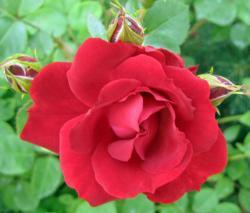
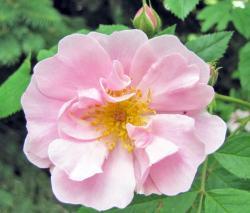
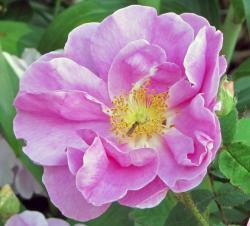
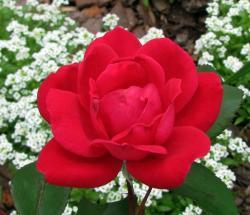
 The month of May brings more vivid color and greenery to the
The month of May brings more vivid color and greenery to the home landscape and gardens. It is a month when April's cooler, rainy days and array of flowering spring bulbs give way to May's warmer, sun-filled "shirt-sleeve" weather. May brings with it the iris in all its forms, sizes, colors and glory! It is like an energy drink or snack bar in the form of natural beauty. Temperatures this year have been into the comfortable 70's and even a few lower 80's; and most with sunshine! As I post this blog article it is unfortunately a cool, cloudy and breezy day. Photography of irises today, or at least this morning, is marginal at best. I like sunlight on my blooms to show off their best features and colors. The picture at right was taken in cloudy, somewhat darkened conditions this morning (May 17) around 10:00 AM. Although acceptable, moderate sunlight would have improved the quality of the view. Paul Black's 'Bundle Of Love' is at the bottom of the picture while a clump of I. Pallida Dalmatica forms the background. Having just come off the Irises Celebration Week ending May 15, more than 900 photos (near 1,000) were added to the ATP Database. And innumerable forum posts and comments were made. It was a good week for everyone involved! It was also an enjoyable week for not just viewing, but learning too!
home landscape and gardens. It is a month when April's cooler, rainy days and array of flowering spring bulbs give way to May's warmer, sun-filled "shirt-sleeve" weather. May brings with it the iris in all its forms, sizes, colors and glory! It is like an energy drink or snack bar in the form of natural beauty. Temperatures this year have been into the comfortable 70's and even a few lower 80's; and most with sunshine! As I post this blog article it is unfortunately a cool, cloudy and breezy day. Photography of irises today, or at least this morning, is marginal at best. I like sunlight on my blooms to show off their best features and colors. The picture at right was taken in cloudy, somewhat darkened conditions this morning (May 17) around 10:00 AM. Although acceptable, moderate sunlight would have improved the quality of the view. Paul Black's 'Bundle Of Love' is at the bottom of the picture while a clump of I. Pallida Dalmatica forms the background. Having just come off the Irises Celebration Week ending May 15, more than 900 photos (near 1,000) were added to the ATP Database. And innumerable forum posts and comments were made. It was a good week for everyone involved! It was also an enjoyable week for not just viewing, but learning too!
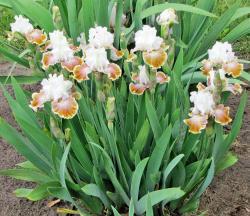
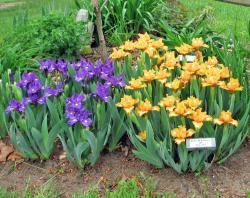 Having been a 'country bumpkin' my entire life I relate easily to ATP, its members and the gorgeous pictures posted by everyone. Especially nice were the iris photos posted between May 9 through May 15, 2015. I am grateful to all the members for sharing their wonderful work! In this blog post I'd like to share some of my own offerings which I consider to be personal favorites. I hate to load a post down with pictures, but they sometimes 'speak' louder than words. At left is shown a clump of Owyhee Desert (L. Pinkston), and at right are Cub Cadet and Stroke Of Brilliance from Paul Black at Mid-America Gardens in Oregon. Irises in some form, cultivar, variety, species or sub-species grow on every continent except Antarctica. So there are innumerable irises everywhere. Even the American Iris Society lists many thousands of registered plants in the MDB, MTB, SDB, TB, BB and LA classifications! It would be impossible for an individual to remember each cultivar, let alone each classification and the varieties within each one. It is nice to just grow some in the home landscape and learn something about them. They are especially effective as speciman plants or in mixed settings with other perennials. My hope is to encourage others, especially the younger generation, by sharing my personal experiences, and pictures with them.
Having been a 'country bumpkin' my entire life I relate easily to ATP, its members and the gorgeous pictures posted by everyone. Especially nice were the iris photos posted between May 9 through May 15, 2015. I am grateful to all the members for sharing their wonderful work! In this blog post I'd like to share some of my own offerings which I consider to be personal favorites. I hate to load a post down with pictures, but they sometimes 'speak' louder than words. At left is shown a clump of Owyhee Desert (L. Pinkston), and at right are Cub Cadet and Stroke Of Brilliance from Paul Black at Mid-America Gardens in Oregon. Irises in some form, cultivar, variety, species or sub-species grow on every continent except Antarctica. So there are innumerable irises everywhere. Even the American Iris Society lists many thousands of registered plants in the MDB, MTB, SDB, TB, BB and LA classifications! It would be impossible for an individual to remember each cultivar, let alone each classification and the varieties within each one. It is nice to just grow some in the home landscape and learn something about them. They are especially effective as speciman plants or in mixed settings with other perennials. My hope is to encourage others, especially the younger generation, by sharing my personal experiences, and pictures with them.
